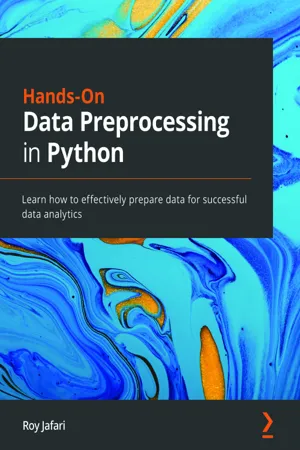
Hands-On Data Preprocessing in Python
Roy Jafari
- 602 Seiten
- English
- ePUB (handyfreundlich)
- Über iOS und Android verfügbar
Hands-On Data Preprocessing in Python
Roy Jafari
Über dieses Buch
Get your raw data cleaned up and ready for processing to design better data analytic solutionsKey Features• Develop the skills to perform data cleaning, data integration, data reduction, and data transformation• Make the most of your raw data with powerful data transformation and massaging techniques• Perform thorough data cleaning, including dealing with missing values and outliersBook DescriptionHands-On Data Preprocessing is a primer on the best data cleaning and preprocessing techniques, written by an expert who's developed college-level courses on data preprocessing and related subjects. With this book, you'll be equipped with the optimum data preprocessing techniques from multiple perspectives, ensuring that you get the best possible insights from your data. You'll learn about different technical and analytical aspects of data preprocessing – data collection, data cleaning, data integration, data reduction, and data transformation – and get to grips with implementing them using the open source Python programming environment. The hands-on examples and easy-to-follow chapters will help you gain a comprehensive articulation of data preprocessing, its whys and hows, and identify opportunities where data analytics could lead to more effective decision making. As you progress through the chapters, you'll also understand the role of data management systems and technologies for effective analytics and how to use APIs to pull data. By the end of this Python data preprocessing book, you'll be able to use Python to read, manipulate, and analyze data; perform data cleaning, integration, reduction, and transformation techniques, and handle outliers or missing values to effectively prepare data for analytic tools.What you will learn• Use Python to perform analytics functions on your data• Understand the role of databases and how to effectively pull data from databases• Perform data preprocessing steps defined by your analytics goals• Recognize and resolve data integration challenges• Identify the need for data reduction and execute it• Detect opportunities to improve analytics with data transformationWho this book is forThis book is for junior and senior data analysts, business intelligence professionals, engineering undergraduates, and data enthusiasts looking to perform preprocessing and data cleaning on large amounts of data. You don't need any prior experience with data preprocessing to get started with this book. However, basic programming skills, such as working with variables, conditionals, and loops, along with beginner-level knowledge of Python and simple analytics experience, are a prerequisite.
Häufig gestellte Fragen
Information
Part 1:Technical Needs
- Chapter 1, Review of the Core Modules of NumPy and Pandas
- Chapter 2, Review of Another Core Module – Matplotlib
- Chapter 3, Data – What Is It Really?
- Chapter 4, Databases
Chapter 1: Review of the Core Modules of NumPy and Pandas
- Overview of the Jupyter Notebook
- Are we analyzing data via computer programming?
- Overview of the basic functions of NumPy
- Overview of Pandas
Technical requirements
Overview of the Jupyter Notebook
- Space for individual exploratory work
- Space for collaboration
- Space for learning and education

